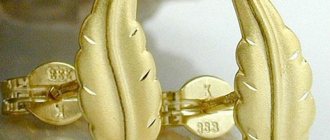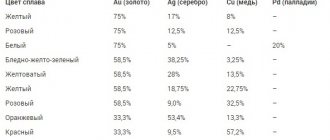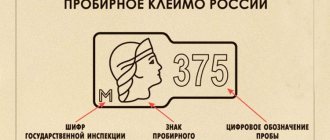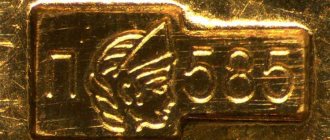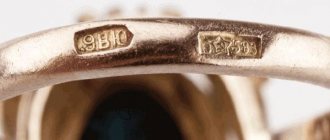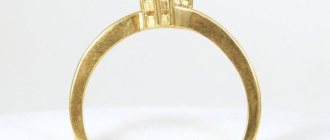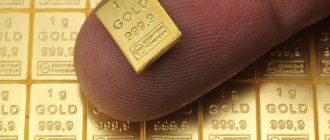Gold was the first noble metal discovered by man, and today it has found application in many areas. Gold has been the most successful market in the jewelry industry. At the same time, there is a gradation of the value of the metal. Every woman, receiving a jewelry gift from a man, will definitely pay attention to the fineness or carats. This indicator informs about the amount of pure precious metal used to make jewelry. How can one learn to evaluate the purity of the alloy and quality by the mark on the product?
Meaning and origin of the word "carat". Composition of gold in bullion and consumer goods
The word carat translated from Latin means “carob.” Its origin is Eastern countries. The value of the plant is represented by its seeds, which became the prototype of the unit for measuring the purity of gold. Previously, they were used to measure the weight of expensive stones.
Carat of gold
This valuation method was not the most reliable, so traders from different countries decided to equate 1 carat to 205 mlg. Later, the established weight was reduced for convenience to 200 mg. And today, this measuring system remains the only one for assessing precious stones throughout the world.
Over time, traders began to value not only stones as valuable seeds. The gold carat allowed us to determine the quality of rings, earrings, bracelets and other jewelry. The maximum gold content according to the grading system is 24 carats.
This is exactly what is indicated on bank bullion. However, pure gold is very soft and unsuitable for creating various products. Therefore, impurities are added to it to improve consumer qualities. This is where the carat value of the products becomes important, showing the optimal ratio of gold and alloy.
What is carat
We are used to thinking about weight in grams, kilograms and tons. Many people know something about pounds and ounces. However, gemstones, metals and pearls have their own unique measurement system. European civilization owes its appearance to Eastern culture.
In ancient times, in many countries of the Mediterranean and the Middle East, people used their weight standard - talent, which means scales, weight. It was also a measure of value and had its own differences for different states:
- Babylonian - 60.4 kg;
- Jewish - 44.8 kg;
- Phoenician silver - 43.59 kg;
- Persian gold - 25.2 kg, silver - 33.65 kg;
- ancient Greek - 26.20 kg.
The ancient Greek talent consisted of 6,000 drachmas, which was both a coin and a unit of weight (4.37 grams). Each locality also had its own drachma : Rhodian, Corinthian, Attic, Lydian, etc. To avoid confusion, a conversion factor was established - mina. One mina was equal to 100 drachmas, and 1 talent was equal to 60 minas.
Time is leisurely, until you get with your caravan from Babylon to Egypt, you will have time to comprehend and practice all this. And then in the market you will test the flexibility of your mind: talents in drachmas through mines and back. It is not surprising that with the development of trade, humanity sought to create more unified systems of weights and measures.
Jewelers were the first, since the weight range of their goods was far from kilograms. They found a convenient standard for themselves - carob fruits. This plant of the legume family has been cultivated since ancient times in the countries of the Mediterranean basin. Its seeds are distinguished by their constant mass and are convenient as a measure of scales. The name of these small grains sounded different in different languages. The name carat has become generally accepted. The abbreviated spelling is car, in the Latin alphabet it is ct, in electronic exchange it is denoted CD.
Although jewelry makers moved closer to a common standard, some differences remained until the early 20th century:
- English carat - approximately 0.2054 g;
- Arabic carat (qirat) - 0.2232 g.
And only in 1907, at the General Conference on Weights and Measures, held in Paris, a non-systemic unit of mass measurement used in jewelry was approved, equal to 200 mg (0.2 g), expressing the weight of 1 carat in grams. In a numerical value, it is written as a decimal fraction with the obligatory indication of two digits after the decimal point, even if these are zeros.
Gold purity grading systems
In the history of the jewelry industry, there were 4 systems for assessing the purity of a gold alloy: lot, spool, metric, and carat. However, today only the last 2 are relevant, with the help of which the amount of precious metal can be measured.
Metric system and samples
Russia and some post-Soviet states use a metric system for assessing metal purity. According to it, the sample shows the amount of pure gold in 1000 parts of the alloy. In other words, how many milligrams of gold does 1 gram of alloy contain?
The following acceptable indicators have been approved: 375, 500, 585, 750, 900, 916, 958, 999. However, the range is not limited to these samples, they are only frequently used.
Stamps on precious items
Carat system. Carat value
This system includes the following values: 9, 12, 14, 18, 22, 23, 24. 24 karat gold is considered pure, containing a minimum of impurities. The carat of gold shows the amount of pure metal in the alloy relative to 24 carats. The system is used by world jewelry experts to determine the percentage of pure metal in products.
In the USA and European countries, the purity of only gold alloys is measured in this way; it is not applicable to other metals.
Spool system of Tsarist Russia
For more than two centuries, Russia used a spool measurement system to assess the purity of precious metals. With its help, silver and gold were assessed, comparing them to the number of spools. And only in 1927 it was replaced by metric measurement.
The spool unit, like the metric one, helps determine the ratio of pure precious metal and alloy. Its basis is 96 units - spools. Precious metal 999 corresponds to 96 spools.
To convert the spool valves to the usual value you need to: divide the spool indicator by 96 and multiply by 1000.
Ingots 999.9 fine
Weight and numbers
Despite all the intricacies of measurements, I would like to know how many ordinary grams familiar to our people are in a gold product. So, first, let's look at the metric carat. It was first used in Spain. This is a weight equal to ⅕ grams, or 0.2 grams or 200 mg. The tradition of medieval measurements is continued here, the only difference being a more accurate standard figure.
Nowadays the British karat system is used to indicate the purity of gold samples. With its help you can find out the percentage of gold content and the percentage of impurities. The number 24, which is the maximum and corresponds to 100%, is easily divided in half and into other equal shares. So, 12 carats is 50% pure gold, 6 carats is 25%, 18 carats is 75%. For other figures, the percentage of 1 carat will help - 4.2%.
Carat and fineness of standard gold on the world market
The carat rate for valuing jewelry is used by America, Great Britain, Switzerland and other European countries.
The gold standard on the world market is considered to be 24 carats. Every day, the price of gold is determined on the precious metals exchange precisely in relation to bank bullion, which consists of 99.99% of the precious metal. The purity of such gold reserves is 999.
Using a simple example of calculating the ligature, you can understand how the standard and carats relate. To find out how much ligature the alloy contains, you need to subtract the number of carats on the stamp from 24k. 12k jewelry uses 12k other metals. This simple translation allows us to equate carats to a metric indicator, in which 1000 grams (24k) consists of 500 grams of gold (12k) and 500 grams of alloy (12k). Accordingly, 12k = sample 500.
Formula for converting carats to fineness
The bank bullion consists of 99.9% pure precious metal. In Russia, the metric system with a marking mark in the form of a sample has been officially adopted for the evaluation of jewelry. Any indicator of other measurement systems can be easily converted to obtain the share of the precious metal used.
To determine which metal sample corresponds to the specified number of carats on the product, you can use a simple formula:
carats / 24 * 1000
The resulting figure will be in the range of values of the metric system.
Sample purity
Samples can be converted to the karat system. The purest standard used in jewelry is 958. It corresponds to 23 carats. Impurities here are necessary to change the properties of the material towards greater strength. 22 carats is 917, also quite pure. 18 carat or 750 standard is a traditional type of alloy that allows you to create a balanced alloy with other metals. It is this numerical indicator that can be called optimal. 14 carat - 585 gold. It is very common both in Russia and in Europe. Due to the large percentage of impurities, it can obtain an original shade, and also has sufficient hardness for various jewelry manipulations - twisting, stretching, straightening to the state of a sheet. 10 carats is 416 fine, and just over 40% pure gold. This is the lowest metal purity standard in the United States. In Russia, 375 fineness of 9 carats is also acceptable. In the East, the 8-carat marking, containing 33.3% gold, is also used. To convert gold in carats and convert it to the metric system, the table below may be useful:
Table: ratio of different rating systems
| System | Carat | Metric |
| Zolotnikovaya | ||
| 36 | 9 | 375 |
| 48 | 12 | 500 |
| 56 | 14 | 585 |
| 72 | 18 | 750 |
| 88 | 22 | 900 |
| 92 | 23 | 958 |
| 96 | 24 | 999 |
Gold ring with a stamp 56
Where to find the stamp, sample and manufacturer's mark on the product
Each ring, bracelet, chain and other jewelry must correspond to the standard, one of the existing rating systems. Any jewelry salon can only sell jewelry that bears the state hallmark. This imprint is called a name tag and includes numbers and letters. The numbers indicate the year of manufacture and sample. The letter symbol indicates the manufacturer.
Any jewelry is sold with a label, details: name of the manufacturer, name of the jewelry, code, article number, weight. Additionally, the size of the item and the name of the inserts, if any, are indicated. According to GOST, the label is attached to the products with white thread and a seal.
Marking on a product is regulated and carried out only by the Assay Chamber of the Ministry of Finance of the Russian Federation. The state mark can be affixed using a laser or minted. The presence of such a sign indicates the authenticity of the jewelry and the passage of appropriate checks.
Includes a sample, a sign of identification, which are applied in one or different images. The ID symbol can be an image of a star with a hammer and sickle, characteristic of Soviet gold, or the head of a woman in a kokoshnik, turned to the right.
A little about this test
The state gold reserve is formed from 24 carat metal. In Rus' it was called red for its red color when heated. To obtain the purest metal, the ore is subjected to an expensive refining process.
Composition and properties
The metal consists of 99.9% pure gold. According to State Standard No. 30649-99, additives can be lead, iron, antimony, bismuth, copper, and silver.
The amount of additives should not exceed 1/10 percent. By agreement with the Assay Office, palladium and platinum can be used as additives.
Au 24 carat has a number of features:
- Temperature changes and high humidity are not dangerous for the precious metal. Au 24 carat is ductile and corrosion resistant. The surface is not covered with plaque under any conditions.
- A metal of the highest standard, like any chemical element, is exposed to the aggressive effects of chlorine, a mixture of nitric and hydrochloric acids of high concentration.
- The product turns out fragile and soft. Jewelry is easily deformed, so jewelers rarely use 24-karat gold.
- It is used extremely rarely as a material for the jewelry industry due to its high cost.
Strength
24 carat gold has a strength of 120 MPa. It is classified as a material subject to deformation. Expensive jewelry breaks under physical stress.
Expert opinion
Vsevolod Kozlovsky
6 years in jewelry making. Knows everything about samples and can identify a fake in 12 seconds
The hardness is 18 HB. The metal is soft, marks remain on the surface if you run a knife across it. Melting point – 1063 degrees Celsius. The color of the molten metal is greenish. Aurum boils at 2947 °C.
Pure 24-karat gold is malleable and ductile. One gram can be rolled into foil with an area of 1 square. m or make 2.5 m of wire.
Alloy shade chart
The color of jewelry alloys depends on the type of impurities. 24 carats is a pure metal, there are practically no additives in it. Therefore, the color remains constant - bright yellow. The table shows the color change of Au with various impurities.
| Share of gold, % | Proportion of impurities, % | Main composition of impurities | Alloy color |
| 99,9 | 0,1 | Silver, palladium, platinum, copper | Yellow |
| 96,0 | 4 | Copper | Yellow |
| Copper | Red | ||
| 75,0 | 25,0 | Copper, silver, nickel; copper, silver | Yellow |
| Nickel, zinc, copper; palladium, silver, copper | White | ||
| 50,0–58,0 | 42–50 | Copper, silver | red |
| Silver, copper | Yellow | ||
| Silver, copper | Green | ||
| Nickel, silver, zinc, copper | White | ||
| 37,5 | 62,5 | Copper, silver | Red |
| Silver, palladium, copper | Pink |
Brand
Precious products are subject to mandatory branding. This procedure is entrusted to the Assay Supervision Inspectorate established by the state. The shape of the stamp is a blade, consisting of 3 blocks:
- inspection code;
- assay mark;
- sample designation.
The Russian print depicts the profile of a woman's head in a kokoshnik, turned to the right. The form of the brand was introduced in 1994.
Each 24k gold piece contains a seal secured with white thread. Unsealed products are not allowed for sale.
How much does 1 gram of gold of this standard cost?
The highest standard is more expensive than other alloys. The cost is determined by the amount of gold reserves and the dollar exchange rate. According to the Central Bank of the Russian Federation, the average price of a gram of 24 carats today is shown in the graph:
| Price 999 standard according to the Central Bank | Market value of the sample today | Scrap price | Price in jewelry |
Why is it better to trust the sample on the product?
Each piece of jewelry of domestic or imported origin must have the necessary markings. Imported gold jewelry is always marked with carats and the word “gold”. Certificates for trading are required.
It is important to correctly read the existing name tag, especially on products brought from other countries. After all, most of such jewelry is gold-plated jewelry or silver, which is also indicated by the presence of appropriate markings. Moreover, the price of these jewelry may correspond to the original.
Any gold jewelry brought for sale in the Russian Federation requires assaying. Then the fineness is indicated along with the carats.
Determining the carat value of a product using the acid method. Instructions
Using simple methods, you can establish the authenticity of gold. But how to determine the sample or carat? It is difficult to do this at home, since you will have to purchase special reagents. A jeweler can use the acid method to determine the purity of items. It is also used in pawnshops, buying precious items. To do this, a small scratch is made on the jewelry, onto which a little acid is dripped, which reacts with the noble metal. Based on the result, you can determine how many carats the product corresponds to.
Step by step test execution:
- Clean the product from dirt and make a small scratch.
- Take reagents intended for different carats. First, apply a drop from the bottle with the lowest reading onto the scratch. If the carat value is higher than that indicated on the bottle, the color of the alloy will not change. Then the experiment must be repeated until a match is found.
- When the carat value of the reagent matches the precious metal, the location of the damage will slightly change the shade. If the value of the jewelry differs by several carats, the scratch will be covered with light rust. If the alloy has a quality several carats higher than indicated on the bottle, then the scratch will dissolve and disappear.
Category: question-answer
There are many tips on the Internet on how to test gold. How to determine the purity or carat of gold?
Expert opinion
Pribrezhny Gennady Valentinovich
Jeweler 6th category
Each piece of jewelry sold in Russia must have a hallmark and a hallmark. If there are no marking symbols, this may indicate restoration, alteration of the jewelry, or rare single hand-made work in which a mark is not placed. Then, if you have special reagents or other tools, you can determine the sample yourself. But it is better to visit a specialist who can accurately determine the authenticity and composition of the gold. The best decision would be to buy in jewelry stores with a good reputation and guarantee, for example, in the Sunlight chain, Almaz Holding, MYuZ.
How to convert carats into carats when buying jewelry abroad?
Expert opinion
Grishanov Mikhail Petrovich
Jeweler, director of the Grishanov and Co. workshop
When buying imported jewelry abroad, it is important to pay attention to the stamp and the presence of other signs indicating authenticity. In rare cases, a foreign alloy may not be as pure as the corresponding sample. You can bring this indicator to the usual standard using the formula: carats / 24 * 1000.
How many carats is pure gold?
Expert opinion
Pribrezhny Gennady Valentinovich
Jeweler 6th category
The precious metal acquires a white color by adding more silver or palladium to the alloy. Today it is a popular alloy with hallmarks: 585, 750, 900. Thus, the carats of white metal are fully consistent with those of yellow, respectively.
Gold granules
How much is a carat of gold in grams?
Expert opinion
Grishanov Mikhail Petrovich
Jeweler, director of the Grishanov and Co. workshop
It is believed that in 1k there is 0.2 grams. But this indicator is used to measure the weight of precious stones exclusively. There is even a special table indicating the carat of stones with the corresponding weight.
What are the shades of alloys?
Gold alloys marked 10K come in a variety of colors and shades: yellow, white, pink, etc. For example, in Turkey, where Russian women most often bring jewelry, shades of yellow predominate, and the cost of products rarely exceeds $50 per gram. Our compatriots export beautiful jewelry in delicate pink and white from China.
To obtain a white tint, palladium and silver, sometimes nickel, are added to the gold alloy, after which it is coated with rhodium, which gives the product shine. This makes the alloy so beautiful that it is difficult to distinguish it from more high-grade jewelry: visually it can even be mistaken for platinum.
In Italy you can find and buy gold earrings or rings made of 10K green gold. The alloy gets its green tint by adding cadmium and rubidium to it, which are not used in Russia due to the toxicity of cadmium and the excessive fragility of the product created by rubidium additives. However, a greenish tint can be given to jewelry by adding copper, silver, zinc and nickel in certain proportions. In addition to green, 10 K and 9 K alloys come in lemon color, a dull grayish tint, pink with the addition of copper and silver, and others.


